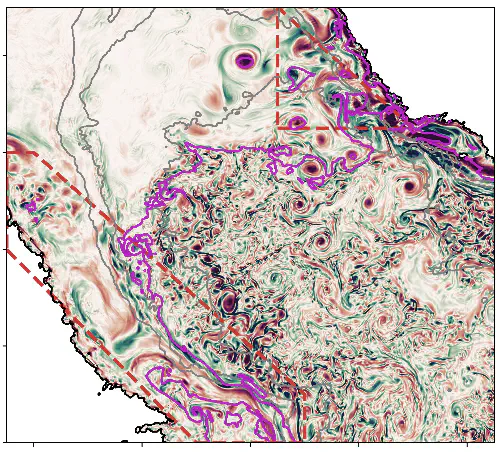 Relative vorticity on 2012-01-08 in LLC4320. The magenta line represents 10% of sea ice concentration. Grey contours represent 1000m, 2000m and 3000m isobaths. Red dashed boxes denote the LC and WGC regions defined in Brandt et al. (2004).
Relative vorticity on 2012-01-08 in LLC4320. The magenta line represents 10% of sea ice concentration. Grey contours represent 1000m, 2000m and 3000m isobaths. Red dashed boxes denote the LC and WGC regions defined in Brandt et al. (2004).Abstract
The formation of fresh, cold, oxygenated and carbon dioxide-rich Labrador Sea Water is a critical process which affects global climate by ventilating the deep ocean. Understanding the mechanisms that control the convection and generation of deep water in the Labrador Sea remains crucial. This study employs a high-resolution numerical simulation run of the Massachusetts Institute of Technology general circulation model to examine how sea ice changes affect freshwater fluxes in the Labrador Sea, primarily via (sub)mesoscale activity in the Labrador Current region. Sea ice is a thermally-insulating barrier, limiting the heat exchange between the ocean and the atmosphere. Consequently, a decrease in ocean heat loss results in shallower mixed layer depth, leading to a lower depth penetration of submesoscale instabilities. In addition, the highly-consolidated sea ice greatly suppresses the intensity of eddy activity. Our results indicate that (sub)mesoscale dynamics likely play an important role in freshwater intrusions into the deep convection region. With the future reduction of sea ice under a changing climate, the Labrador Current region might become an essential source of freshwater to the open Labrador Sea, which could influence or even stop deep convection and Labrador Sea Water formation.